Abstract
Introduction:
The blood mobile is one of the modern methods of mobile blood collection facility funded through the third phase of National AIDS Control Programme by the National Blood Transfusion Council of India.
Material and Methods:
A retrospective analysis of data in relation to the blood mobile was carried out with respect to the number of blood donation camps, number of blood units collected, adverse donor reactions, and the expenditure that occurred during the blood collection in the blood mobile from 1st January 2012 to 30th June 2014.
Results:
There were 64, 84 and 62 blood donation camps conducted in the blood mobile with collection of 3301, 5166 and 2842 blood units during 2012, 2013 and the first half of 2014. The percentage of voluntary blood collection in blood mobile was 8.5% in 2012, increased to 12.4% in 2013 and stands at 14.39% in the first half of 2014. The difference in the means of the adverse donor reactions in the blood mobile and the outdoor camps was not statistically significant.
Discussion and Conclusion:
The blood mobile is definitely an asset as far as augmentation of voluntary blood donation is concerned, ensures stable collection of blood for better provision of blood and blood components. However the facility requires a comprehensive annual maintenance with incorporation of onsite quick response team both from the manufacturer of the vehicle, and the blood collection equipments. Adequate provision of funding for operational expenditure would in turn facilitate optimum utilization of this facility.
Keywords: Blood mobile, National AIDS Control Organization, National Blood Transfusion Council
Introduction
The blood mobile is one of the modern methods of mobile blood collection facility funded through the third phase of National AIDS Control Programme by the National Blood Transfusion Council of India.[1] Thirty-two blood mobile were distributed across the country for the augmentation of voluntary blood donation. The concept was to reach the blood donor with the blood collection facility in order to minimize the time spent on travel to the nearest blood donation centre or outdoor blood donation camp/drive.[2] The blood mobile was manufactured with the concept of stationing it for blood collection at prominent public places and rotate the schedule in a manner that regular repeat voluntary blood donors know that the blood mobile will be stationed for collection near his/her workplace/housing, and could thus plan his/her blood donation in advance. The present study was carried out to present the data on the utilization of this modern blood collection facility in terms of augmentation of voluntary blood donation, the additional expenditure incurred on blood collection by this facility and to compare the adverse donor reaction in blood donors donating blood in the blood mobile when compared with blood donation in other outdoor blood donation camps. There is at present no published literature on the utilization of this facility from our country.
Materials and Methods
A retrospective analysis of data in relation to the blood mobile was carried out with respect to the number of blood donation camps, number of blood units collected, adverse donor reactions, and the expenditure that occurred during the blood collection in the blood mobile from 1st January 2012 to 30th June 2014. The blood mobile was under repair from November 2012 to January 2013 (therefore the period was not included in data evaluation).
Infrastructure and process flow for blood donation
The blood mobile is the incorporation of entire blood donation centre's facility in a heavy motor vehicle. This facility was designed keeping in view the process flow of blood donation, so as to enable the entire functioning inside this blood mobile. The entire functional area of the blood mobile is divided into four compartments, starting from the front end; first is the predonation waiting area, then medical screening area and phlebotomy area, followed by postdonation and blood storage area in the rear end.
Predonation waiting area: There are two entrance doors, one for the driver, and the other a pneumatic door for the entrance of the prospective blood donor. There is seating for six people, this may be utilized to enable the blood donor to sit and fill in the blood donor questionnaire and consent proforma. One liquid-crystal display (LCD) is installed in this area for donor's audio-visual engagement
Medical screening area: This area is provided for the medical officer to perform the screening of the blood donors. The medical officer obtains the relevant history from the donor and performs a physical examination. Donors are allowed to donate only if declared fit for donation by the medical officer
Phlebotomy area: This area has four blood donor couches installed where the donation can be performed with blood collection monitors placed for optimum collection of the required quantity of blood as depicted in Figure 1. Tube sealers are provided for maintaining the closed surgical environment within the blood bag. The donor couch can be reclined in the event of any adverse donor reaction. There are two LCD's for donor's convenience (donor engagement in watching audio-visual aids provides soothing/calming effect and divert the attention in order to attenuate anxiety)
Postdonation and blood storage area: This area has a capacity of seating of four donors and a domestic refrigerator and microwave so as to store the refreshments for the blood donor. There are four blood storage refrigerators with the option of storing blood at 4°C and 22°C (cold chain).
Figure 1.
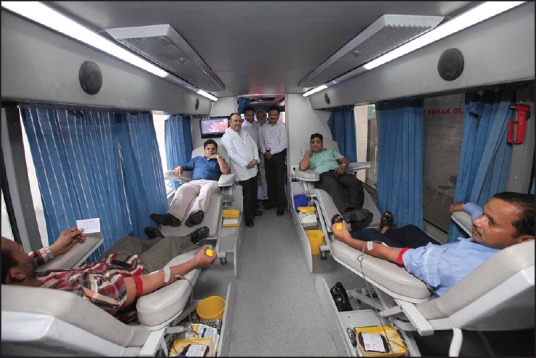
Phlebotomy area of blood mobile
The entire blood mobile is air-conditioned for the donor's comfort. There is a toilet facility in the donor waiting area and hand washing facility in the postdonation area.
Automotive design
The blood mobile runs on two engines, one for the routine functioning (vehicle engine) and the other supported by a diesel generator to provide air-conditioning when the blood mobile is stationed for blood collection, however, in case of generator failure the blood mobile can be kept in idle mode and air-conditioning can thus be also provided by keeping the primary engine switched on during blood collection process. This mode is also available when the diesel tank is <50% full (250 L) since the generator does not function below half tank capacity. Then there is a petrol generator to provide a power source for the functioning of the donor couches, blood collection monitors, the blood storage refrigerators, domestic refrigerator and the microwave. In case there is a power option of 32 A available at the collection site, then the petrol generator function can be obviated, and there is a 50 m long electric wiring inbuilt in the blood mobile to provide the alternating current power source connection. The inverter charges during the travel and provides support to the lighting inside the blood mobile. The blood collection in the blood mobile taking into consideration 10 min for each donor on the couch, would translate into 24 donors in 1-h. Therefore the collection in a 5 h drive would on an average be 80-100 blood donors keeping in view the time spent on adverse donor reaction, difficult phlebotomy or extra time on couch for first time donors; presuming that donors come in continuity.
Results
There were 64, 84 and 62 blood donation camps conducted in the blood mobile with collection of 3,301; 5,166 and 2,842 blood units during 2012, 2013 and the 1st half of 2014 as depicted in Figures 2 and 3. Figures 4 and 5 depict the annual and monthly trend of camps and blood donations in the blood mobile. The percentage of voluntary blood collection in blood mobile was 8.5% in 2012, increased to 12.4% in 2013 and stands at 14.39% in the 1st half of 2014 as depicted in Figure 6. Data represented in Table 1 depicts the blood collection, adverse donor reactions in blood mobile and outdoor voluntary camps. Notably the adverse donation reactions in blood mobile increase during the summer months peaking steeply from April onwards consistently during all 3 years of comparison and outnumber the adverse reactions in other outdoor camps, but decrease during the winter months as depicted in Figure 7. “However the difference in the means of the adverse donor reactions in the blood mobile and the outdoor camps was not statistically significant”.
Figure 2.
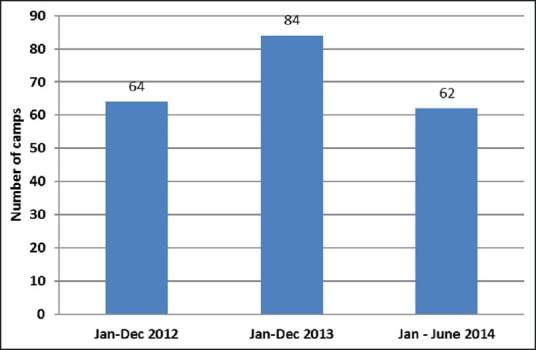
Annual trend of camps in blood mobile
Figure 3.
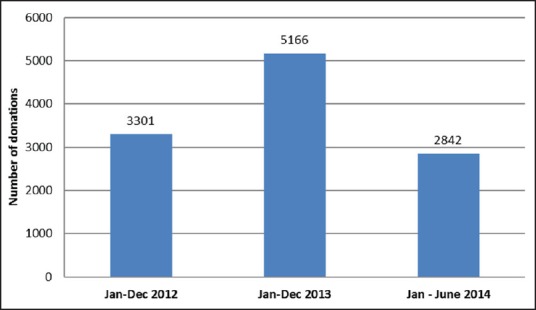
Annual trend of blood donations in blood mobile
Figure 4.
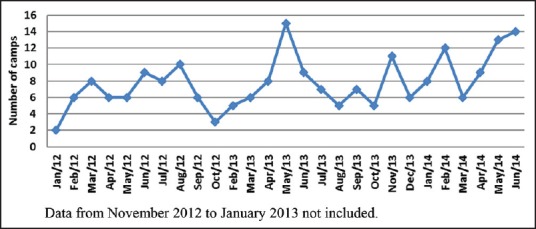
Monthly trend of camps in blood mobile
Figure 5.
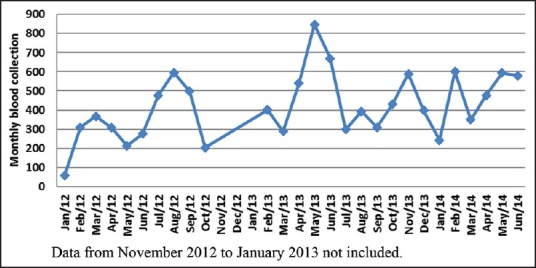
Monthly trend of blood donations in blood mobile
Figure 6.
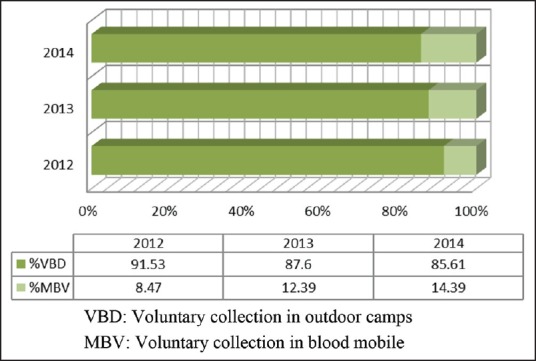
Percentage distribution of voluntary blood donations in blood mobile and outdoor camps
Table 1.
Blood collection and adverse donor reactions

Figure 7.
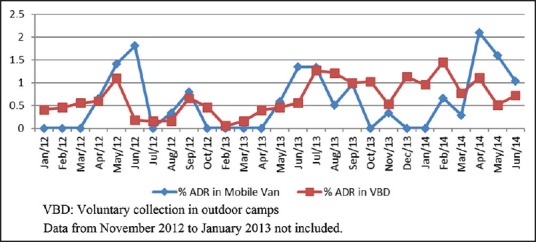
Comparison of the monthly trend of adverse donor reactions in blood mobile and outdoor camps (percentage)
Discussion
The blood mobile has resulted in augmentation of voluntary blood donation at our institute. The facility was utilized to collect 11,309 blood units over a span of 27 months; resulting in an average addition of 418 blood units/month or about 14 blood units/day. The blood collection in the blood mobile in terms of percentage of voluntary blood donation was 11.8% on an average/annum over the period from January 2012 to June 2014. The extra cost incurred during the blood collection in blood mobile was Rs. 112 per blood unit; considering the expenditure under the heads of fuel consumption, repair and staff salary of only those deputed from National AIDS Control Organization. The adverse donor reactions during blood collection in the blood mobile demonstrated a trend of increase in donor reactions during the summer months; and rather surprising decrease in donor reaction during the winter months [Figure 6]. This could be due to the fact that the donor comes as well as returns to the outside hot/humid weather condition where the postdonation refreshments are served and predonation registration is done. This observation is despite the regulated process flow of donors in the blood mobile. The predonation waiting inside the blood mobile and the postdonation mandatory waiting before the movement of the donor outside for refreshments provide gentle acclimatization to the donors, in an attempt to avoid sudden change of temperature. The decrease noted in adverse donor reactions during the winter months could be because the blood mobile provides a comfortable environment when the outside weather conditions are extremely cold.
Operational advantages with this blood collection facility
The blood collection in the blood mobile can be scheduled in a manner to ensure blood supply during the periods when outdoor blood collection camps are limited by the extreme climatic conditions and the young source (college going students) of blood is on summer vacations.
The blood components prepared from the blood collected in the blood mobile buffers the inventory, especially of the short shelf life blood component like platelets so as to optimize the platelet inventory.
The workflow the staff working inside the phlebotomy area is optimized by the closely placed blood donor couches in the cubicle. Moreover the blood collection monitors aid the optimization of staff work as they not only clamp the tube segment consequent upon the draw of set volume of blood but also raise an alarm, when compared to the manual monitoring in other outdoor blood donation camps in resource-constrained settings. Therefore, the staff required to conduct voluntary blood donation in the blood mobile is less when compared with the outdoor blood collection.
The blood mobile is a preferred mode of conducting blood donation wherein about 80-100 blood donors are expected to donate blood. The camp organizers prefer this facility as it saves on them the cost of tent-age, space requirement and moreover the blood donors are more comfortable donating blood inside the air-conditioned blood mobile.
The excitement to find out as to what is going on in the blood mobile is very important in providing the trigger in a first time blood donor to donate blood, and at the same time in a regular donor to donate again in order to have the experience of this new blood collection facility. Further the blood donors are ready to wait for their turn so as to experience the blood donation in this facility. Thus this collection facility seems to provide the much-needed impetus for blood donation in those who have been contemplating donating blood.
Desirable operational requirements
There are a few desirable operational requirements that can facilitate the utilization of blood mobile for optimizing the blood collection.
The sanction of funds for the blood mobile in terms of fuel requirement is inadequate, financial problem is also encountered during the transit period between the closing of accounts and sanction of funds for the next financial year.
There is no provision of onsite quick response rescue team from the manufacturer which is very much required as a technical snag may lead to total/partial nonoperation of the facility, when you are in the middle of a committed blood collection camp/drive. This may lead to loss of trust among the camp/drive organizers and blood donors bestow on the transfusion services.
The heavy duty vehicle and the biomedical equipments installed in the facility were under contract with the manufacturer for maintenance; however, the initial annual maintenance (AMC) was for a period that has elapsed. Thus, the blood mobile may be in for a challenging time ahead in terms of service and repair of both the heavy duty vehicle and the biomedical equipment installed within till the AMC is executed.
Conclusion
The blood mobile is a state of the art modern blood collection facility manufactured by the unique blend of the technical collaboration between transfusion medicine experts, automobile engineering experts and medical equipment manufactured by biomedical experts.
The blood mobile is definitely an asset as far as augmentation of voluntary blood donation is concerned, ensures stable collection of blood for better provision of blood and blood components.
However, the facility requires a comprehensive AMC with the incorporation of onsite quick response team both from the manufacturer of the vehicle, and the blood collection equipments.
“Adequate provision of funding for operational expenditure would in turn facilitate optimum utilization of this facility that was procured after a heavy financial investment”.
Financial support and sponsorship
Nil.
Conflicts of interest
There are no conflicts of interest.
References
- 1.Blood Safety. Annual Report 2011-12, Department of AIDS Control, National AIDS Control Organisation, Ministry of Health and Family Welfare, Government of India. [Last accessed on 2014 May 05]. Available from: http://www.nacoonline.org/upload/reports/NACO%20Annual%20report%202010-11.pdf .
- 2.Sinha K. Mobile blood banks to make donation easy. Times of India, India. 2010. Oct 2, [Last accessed on 2014 May 05]. Available from: http://www.timesofindia.indiatimes.com/india/Mobile-blood./6666697.cms .


